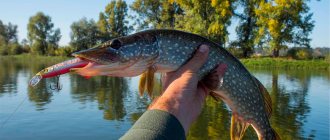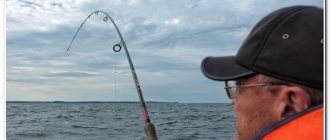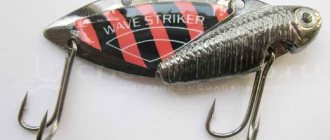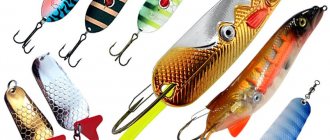Equipping a spinning rod for pike requires a special approach, the factors of which depend on the physiological characteristics of the fish, fishing conditions in its habitat and the bait on which the predator will be caught. For beginners and those mastering pike fishing, spinning is an effective tool with which you can really count on success. But the likelihood of a successful fishing trip largely depends on how competently the fisherman can assemble the spinning tackle for pike, thereby creating conditions for comfortable and rational fishing.
Our conversation will focus on the main issues of spinning rod configuration, assembly nuances and selection of the necessary parameters of equipment elements.
How to equip a spinning rod for pike fishing
Knowledge of the basic and universal configuration of the gear, as well as some nuances regarding the specific direction of fishing for the toothy predator, will help you correctly assemble a spinning rod for pike. A novice fisherman needs to collect his first gear based on the conditions that provide the opportunity to fish with various types of bait. This equipment feature will help you gain initial skills in using both the specialized fishing rod itself and various styles of bait fishing.
As you gain experience, you will be able to delve deeper into the topic and assemble highly targeted gear for a particular bait and its animation style. At this stage, we will focus on the specific collection of spinning equipment for pike for beginners.
Subtleties of fishing in the autumn
The peculiarities of the predator’s behavior in the fall force fishermen to use all sorts of subtleties to catch it. Cooling water and the approach of winter force the pike to become more active in order to stock up on enough nutrients until spring. Catching pike in the fall is as easy as shelling pears, but there are still some features:
- you need to try different types of postings, experiment more often, make more aggressive jerks with the bait ;
- to use larger baits , the coolness pushes even small probes to attack the bait larger than themselves;
- cutting in the fall is carried out immediately ; there is no need to wait during this period;
- the fishing process itself is carried out in early autumn near the coastal zone, on the border with vegetation, near reeds, reeds, water lilies, pondweed;
- as the temperature decreases, fishing in water areas is carried out in places with depths ;
- before freeze-up, pike can be caught only near the wintering pit, where it is already standing in the hope of feasting on it;
- It is precisely before freeze-up that fishing with girders will be successful.
Another feature and subtlety of autumn fishing is the use of stronger gear, since during this period the opportunity to catch large pike increases.
Pike gear has been collected in the fall, the intricacies of fishing have been studied, all that remains is to go to the reservoir and personally try out the tips and tricks received in practice.
You can ask your question to our author:
Selecting a spinning rod
A spinning rod for pike fishing must meet the requirement of low weight. After all, fishing of this type is characterized by a high level of dynamics, with constant re-casts and energetic work of the tackle during the retrieve.
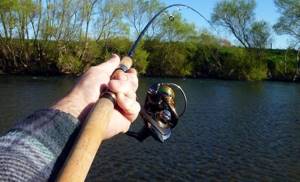
First you need to purchase a composite or carbon-fiber spinning rod of plug-in design. The length of gear for fishing from coastlines of 2.7 meters will be the optimal parameter. If you plan to fish from a boat, then a range of 2.1–2.5 meters will allow you to cast with the best comfort. The semi-fast action makes it possible to practice the skill of retrieves with most types of pike lures, and this characteristic of the form will make hooking the trophy much more reliable than a slower action tackle. A test level of 10–30 grams will cover the entire range of the most suitable simulators for any fishing conditions.
Choosing the right tackle
In order to fish as efficiently as possible from the shore or boat in the autumn, you need to understand that at this time of year there is still vegetation in the reservoir. Therefore, casting too far from the shore will not bring results. Here is what gear is used in the early and later seasons:
- At the beginning of autumn, spinning rods with a length of up to 2.4 m will be optimal. It is better to choose a speed of up to 25 g. You can choose a medium-fast action. You can buy a spinning rod that is average in price.
- As soon as autumn enters its second half, the spinning rod can be changed to a longer one - from 2.7 to 3 m is suitable. It will allow you to make powerful and long-distance casts from the shore.
- The fishing line must be thick enough in cross-section to support such a large, muscular predator. The monofilament version ranges from 0.22 to 0.35 mm. If you prefer to use wicker, then you can take it thinner in cross-section, suitable in the range from 0.15 to 0.2 mm. These fishing line parameters will allow you to support pike weighing from 8 to 15 kg.
- It is necessary to understand that the jaws of a predator can easily cut even a thick fishing line. For this reason, it is necessary to equip the fishing line with a metal leash with a length of 30 to 50 cm.
- The reel must be completely suitable for the selected gear. Both multiplier and inertia-free options with a capacity in the range from 2500 to 3000 are suitable. But, in this case, you must not save and buy original branded products. Since reels made in China quite often malfunction and cause failures and fish failure.
Coil selection
A spinning reel has long been considered a classic element of spinning equipment. An inexpensive and quickly mastered accessory is selected for the fishing rod, comparing its size and weight. The reel must have a friction brake that allows you to change the settings of the maximum force parameters and the volume of the spool that can accommodate one hundred meters of cord.
Important! When buying a mechanism, it is advisable to include a replaceable spool in its kit, which will give the novice fisherman the opportunity to practice his skills on different types of fishing line.

For pike fishing, a reel with a gear ratio of 1:5 is sufficient, and a spool size of 2000–3000 units is enough for optimal thicknesses of braided and monofilament cord in a hundred-meter volume. You should not rush to buy an expensive mechanism. You can also feel the work of the non-inertional system on a product in the mid-price range. The main thing is that the components of the transmission mechanism have a smooth motion, and that the material of the gears and shafts is made of metal alloys. Play in the handle and gaps in the body parts indicate poor quality assembly of the product, which is not worth purchasing.
Read more about choosing a reel for pike fishing.
Friction brake
Spinning pike fishing does not exclude the possibility of catching large specimens of predators, the presence of an adjustable friction brake in the mechanism will help cope with the resistance of which without breaking the tackle. The location of the function in the front part of the reel body makes it easier to adjust the force already in the process of playing the hooked fish, so it is recommended to initially pay attention to this nuance when purchasing. By holding the brake to the limit and applying force to the cord, the spool should stand dead in place. Gradually releasing the clutch and pulling the cord, the spool should slowly release the thread with the characteristic ringing sound of a ratchet.
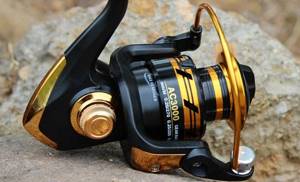
How many bearings should there be in a reel?
The bearings of the mechanism make the inertia-free movement smooth and even without jerking or noticeable limp when turning the handle. But it’s not worth striving to stuff the inertia-free bearings with bearings. Firstly, this complicates the mechanism and requires high costs for its maintenance, and secondly, excess does not guarantee reliability, because these elements do not duplicate each other and the failure of one of them can negatively affect the operation of the entire product. To obtain stable skills, three bearings are sufficient, allowing the reel to smoothly transmit the movement of the handle to a set of toothed shafts and gears.
What does spinning equipment depend on?
The equipment of a spinning rod depends primarily on the following factors:
- From its components. In order to equip a spinning rod, you should prepare the following elements:
- Rod.
- A reel.
- Fishing line.
- Lures.
- The correct equipment also depends on the quality of its components and correct assembly. Even minor mistakes when setting up the tackle can lead to problems in the operation of the entire rod.
- From the technique of application. It is necessary to use spinning tackle only for its intended purpose, that is, do not use it in unintended fishing conditions.
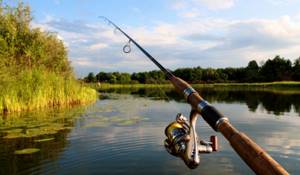
Rod
For this gear, you should use a spinning rod. It must meet the following characteristics:
- Have a test load of twelve to fifteen grams. If the weight of the bait used is less, then the rod test should be from eight to ten grams.
- The length of the spinning rod should be from two to two and a half meters (if the fishing takes place on the banks) and one and a half meters. If fishing takes place from a boat.
- It is recommended to choose a rod with a rigid tip, as it will be much more durable and stronger. In addition, despite its rigidity, the rod itself must be sensitive enough to respond in time to fish bites.
- The action of the fishing rod should be medium, since it is considered universal and can be used in a wide variety of fishing conditions.
Coil
For spinning fishing, two types of reels can be used: spinning and multiplier. The second type of reel is quite difficult to use and has poor performance (short casting, poor sensitivity, etc.), so experienced fishermen recommend using inertia-free types of reels.
When choosing a reel for spinning tackle, you should pay attention to the following characteristics:
- The first thing that should be mentioned is the quality of the reel. If you do not want to purchase a low-quality fake, then do not buy this device from unverified manufacturers and sellers who cannot guarantee good performance of the coil. In addition, when choosing it, you should give preference only to those devices that have a logo from their manufacturer.
- The body of a high-quality reel should be made not of plastic, but of metal.
- The size of the spinning reel should be small, and not small. You should buy something in between.
- The reel should move very smoothly, without squeaks. When purchasing it, the fisherman must personally pick up the device and check the smoothness of its operation.
- A minimum amount of play in the reel and reliable fastening of the line-laying arm are what characterize a reel that will serve well for a long time, so the angler should pay attention to these criteria.
- Number of bearings in the reel. There is an opinion that the more bearings a reel has, the better, but this is not true. In fact, three bearings can spin a reel better than five or seven. It depends only on its quality.
- The reel spool size should be between 2500 and 35000.
- The reel should hold from fifty to eighty meters of fishing line. If it does not hold even that minimum, then such a device will be impractical, since it will be impossible to cast over a long distance with its help.
fishing line
For spinning tackle, you can use monofilament and braided fishing line. It is best to use the latter type of fishing line, since it has the following advantages:
- braided fishing line can withstand a fairly large load and not tear, unlike monofilament fishing line;
- braided fishing line has very good sensitivity to bites;
- the braid does not stretch under heavy loads and does not lose its elasticity, which allows it to be used several times for rigging;
- Braided fishing line is stronger in structure than fluorocarbon and monofilament fishing line.
The best diameter for braided fishing line is considered to be from 0.12 to 0.15 mm.
Lures
The following types of artificial baits are used for spinning:
- Spoons. They are used mainly for winter fishing using the trolling or “track” method. Spoons are metal devices that often imitate small fish due to their play in the water. In addition, spinners can also be in the form of leeches, beetles or other insects.
- Wobblers are a solid artificial bait that most accurately copies the appearance, shape and movements of a live fish. They can be used at different depths and in a wide variety of fishing conditions. In addition, wobblers are used for catching fish by trolling, spinning or “track”.
- Mouse. It is a bait that resembles a mouse in shape and size. It is mainly used for catching large predatory fish such as catfish or asp.
- A spinnerbait is also a bait that is used for fishing with a spinning rod. It is a cross between a spinner and a fly.
- Vibrating tails are baits that are often made of silicone and are shaped very similar to a small fish with a flat tail. Vibrating tails are used by anglers as bait for spinning rods, by attaching them to a hook or jig head. The method of wiring such baits is stepwise.
- Twisters are baits that are made of plastic or silicone. Their peculiarity is that they do not have the shape of a fish, but copy insects, worms or other small animals. When caught with a spinning rod, they are attached to an offset hook or a jig head.
In order to equip a spinning fishing rod with a feeder, you should prepare the following components:
- A rod with a length of three meters and a test from forty to sixty grams.
- A spinning reel with a line capacity of one hundred to one hundred and fifty meters.
- A feeder that will also serve as a sinker. It is recommended to use square or cylindrical feeders.
- Electronic or mechanical bite alarm.
- Fishing rod stand (it is best to use single stands or rod-pods).
In order to equip a spinner with a spinner, you should prepare the following components:
- A fishing rod with a medium action and a length of two meters.
- Spinning reel with size up to 2500.
- Mono line with 0.25 mm diameter.
- Braided line with 0.1 mm thickness.
- Metal leashes should be used to catch fish with large sharp teeth.
To equip a spinning rod with a wobbler, you should prepare the following components:
- A fishing rod with a medium action and a length of two and a half meters.
- Spinning reel with spool size 1500.
- Braided line with a diameter of 0.30 mm.
- Hard leashes.
Which fishing line to choose
The choice of fishing line affects the sensitivity of the equipment . When deciding on the material of the cord, they focus on the fishing distance and the demands of the bait in terms of scrupulous control over the parameters of its game. Braided lines are much stiffer than monofilament lines. The controllability of the bait and transmission of the bite signal when using braided line is higher than when using monofilament fishing line. At the same time, monofilament fishing line allows for more comfortable fishing, compensating for overloads with a high stretch coefficient.
Important! Monofilament is recommended for fishing at short distances and when working with fishing tools that do not require active animation of the angler.

Braided cord
It is believed that it is more practical to equip a spinning rod with a braided cord, since improved control of the bait and the small diameter with relatively high breaking loads of the material provide more advantages compared to monofilament, making the tackle more versatile. In pike fishing, braid with a diameter of 0.12 to 0.18 mm is used.
Important! The color design of the cord has a negligible effect on the success of fishing; basically, this parameter is convenient because it allows the fisherman to better track the process of wiring.
Beginner spinners are recommended to use bright, contrasting thread colors.
Fluorocarbon line
Fluorocarbon fishing line has even more rigid characteristics than braided line, but has low breaking loads. These qualities exclude the prerequisites for using this kind of cord as a basis. Spinners use fluorocarbon to make shock leaders, thereby meeting the needs of fishing on shell rocks and pebble bottoms, where braided line is inferior in reliability and is subject to severe abrasion. This technique helps to achieve reliability of the equipment without reducing the degree of control over the action of the bait.
Basic fishing for pike in autumn
The list of basic and popular ones includes uniform, twitching or jerking, ripping, aggressive, demolition or jumping. Each variety is characterized by a special execution technique.
How to do wiring correctly
| Name | Peculiarities |
| Uniform | Ineffective for pike. There are no active movements, wiring does not attract pike. Used to catch other white predators. |
| Twitching, jerking |
The technique consists of light and smooth movements of the spinning rod horizontally. |
| Riping | The rod is moved in a top-down direction. The advantage of this method is deeper penetration of the bait. |
| Aggressive | The jerks resemble hooking, the bait imitates a fish that is trying to swim away quickly, then returns to its original position with oscillating movements. |
| For demolition | The wiring is carried away by the current. It is important to choose the right weight of the bait so that it does not float up and plow the bottom. |
| Jumping | Jumping movements - sharp twitching of the spinning rod, during which the bait comes off by 5-10 cm. |
Swivel
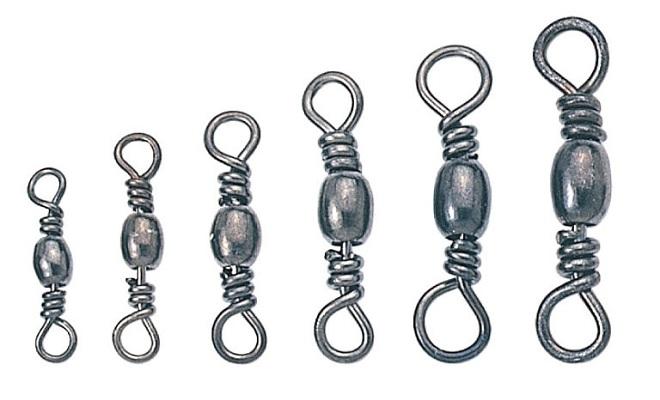
The swivel is one of the effective equipment elements that allows you to qualitatively equip a spinning rod for pike for fishing with rotating spoons. The use of spinners leads to twisting of the cord, which is especially noticeable when using braids. The introduction of a swivel directly onto the winding ring of the hunting accessory eliminates this trouble. When working with other baits, the swivel is not necessary for use; its role becomes useless, making installation only rougher.
Line selection
Almost everyone has a choice of two main types of fishing line that are used when fishing for pike on a spinning rod - monofilament and braided . Each of them has certain advantages and disadvantages. So, which fishing line is best for spinning for pike?
Monofilament
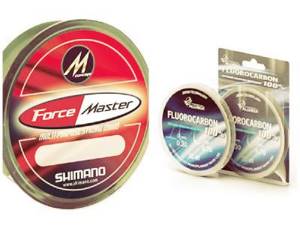
The main advantages of monofilament fishing line:
- ease of installation : all other things being equal, monofilament fits onto the reel spool better than braid;
- elasticity : monofilament stretches easily, absorbing jerks of fish while playing;
- low price.
Disadvantages of monofilament:
- low sensitivity : due to the fact that monofilament stretches greatly, the action of the bait and the bite of fish when fishing with them are felt much worse than when using braided line;
- thickness : monofilament line is much thicker than braided line, and this leads to a decrease in casting distance.
Monofilament thickness
For pike fishing, in most situations, monofilament with a diameter of 0.2 - 0.3 mm is optimal, but thicker ones can be used. A stronger monofilament is suitable when fishing in large bodies of water , where a bite of a real trophy is possible, or when fishing in very catchy, overgrown places, where after hooking it is necessary to bring the pike to the shore as quickly as possible to prevent it from going into the grass or snags.
Braided fishing line
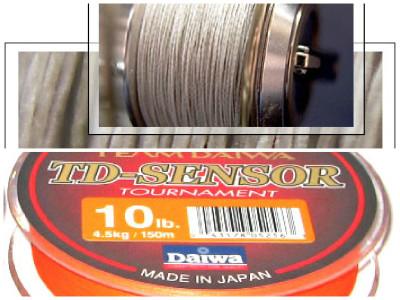
Advantages of braided fishing line:
- low elongation : allows you to perfectly feel the bait and any touch of the fish on it;
- strength : with braided line you can catch pike in the strongest snags, in addition, such a fishing line will not break when fishing for a trophy specimen;
- thin thickness : makes the line less noticeable in the water and allows for longer casts.
Braid has only one serious drawback - its rather high price: the cord costs 3-4 times more than monofilament fishing line.
Choosing a braided line by length – which one is better?
The optimal length of the braid is about 150 meters (100 m is too short, and 200 is too much) . Braid with a length of 140 - 150 meters turns out to be the most durable, fits well on the spool, provides maximum casting distance and minimizes the likelihood of “beard” formation.
Leash
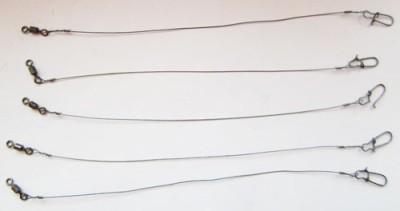
When fishing for pike, be sure to use a metal leash, which will not allow the toothy one to bite the fishing line. You can buy a ready-made leash in a store or make it yourself.
From a guitar string
The leash can be made and prepared independently from an ordinary guitar string of the second or first number . The diameter of guitar string No. 2 is about 0.4 mm, it is suitable for most situations. For hunting for small pike, string No. 1 (diameter about 0.3 mm) is suitable.
On sale you can find many ready-made leashes made of steel or titanium. It is worth paying attention to the quality of the swivels and carabiners with which they are equipped: these elements of equipment often fail at the most inopportune moment, breaking or unbending while fishing for a large pike.
Leash
A distinctive feature of pike fishing is the presence in the equipment of a metal leash that can withstand sharp pike teeth, which is not possible for the material of any main cord. When assembling a spinning rod for a large pike, pay attention not only to the material, but also to the length of the leash, using an element no shorter than 20 cm. Leashes are made of steel, tungsten and titanium. All these materials differ in their rigidity and also in price.

For example, steel leaders are rough but inexpensive. The tungsten leader is much softer, but it has a high price level. The use of a rough leash reduces the attractiveness of the equipment, making the play of baits cramped. The latest trends in pike fishing, which are striving for thinner rigs, have made it possible to use fluorocarbon and Kevlar as leader materials, which, of course, has had a positive effect on the increase in the number of bites. But only time-tested metal leashes provide high reliability against snacking.
Tackle for pike fishing with spinning rod and bait according to the seasons
Depending on the season of the year, the behavior of the predator changes, the degree of its feeding activity either increases or decreases. In connection with these features, the equipment of a spinning rod for pike fishing is undergoing changes, expressed in the adjustment of rigs to the bait used. So that a novice spinning angler can fine-tune his tackle in the right direction, we will consider the annual fishing cycle in the context of using the most promising baits for the season.
Spring
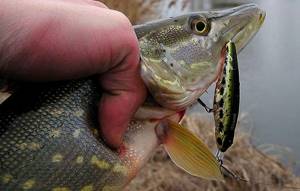
Spring time is characterized by a surge in the activity of pike in the pre-spawning period, a time of no-biting during the spawning itself, a post-spawning glutton and the transition of the fish to a sedentary lifestyle with insignificant feeding activity. Spring is characterized by the use of small-sized baits with intense play in fishing. Crank-type wobblers and spinners fit these definitions. The distinctness of the play of these instruments provides the prerequisites for the use of nylon cords in equipment.
Summer
In the summer, the toothy one becomes capricious. The abundance of natural food available to the fish forces the fisherman to look for bait that most closely imitates the behavior of the fry. The rod's fast action coupled with thin braided line allows for the highly controlled animation required for minnows and topwater poppers. The use of this type of simulators in the summer season is a priority.
Autumn
The protracted period of the predator's autumn feeding period makes it possible to reduce the requirements for the quality of animation of baits. To increase the reliability of the equipment, you can use a medium-action rod without increasing the diameter of the braided cords. The sizes of baits are increased in the hope of catching large specimens of the trophy. Pike fishing gear in the fall may be coarser compared to equipment at other times. In the autumn, silicone baits, spinners and wobblers of various types are used.
Rigs and baits
Spoons. No special equipment is required for fishing using spinners.
They themselves are quite heavy, especially the “oscillators”, to additionally load the tackle. You just need to connect them to the leash through a swivel to avoid twisting the line. Carolina rig. With wobblers, silicone baits and jig baits, additional weight becomes a necessity. The most useful rig for pike is the Carolina rig. This is a sinker sliding along the main line, locked on a leader knot. Promotes snag-free wiring among algae.
Retractable leash. The second type of popular rig for pike fishing is the Moscow rig. But it is a little more prone to catching grass.
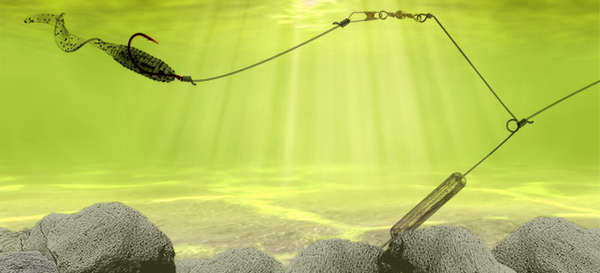
Retractable leash (Moscow equipment)
How to act against snags
- It is useful to camouflage hooks for pike with feathers, but without excess, so as not to disturb the action of the bait.
- In jig rigs, it is imperative to use offset hooks, which allow you to attach a silicone bait in such a way that the hook is hidden at the surface of the silicone. When biting, the sting easily reaches the target. But the equipment does not collect algae.
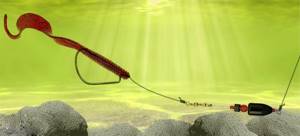
Carolina rig (Carolina rig) with twister on offset hook
The Texas rig is ideal for catching pike in very overgrown areas. It practically does not get caught due to the absence of leashes and the presence of an offset hook. It is also very maneuverable due to the constantly moving sliding sinker.
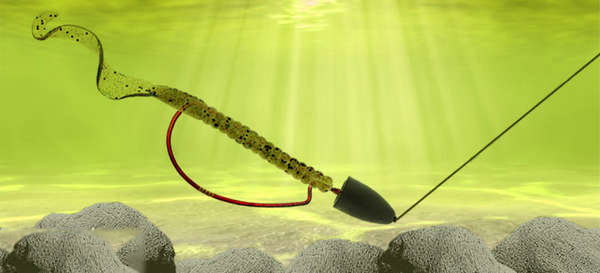
Video on proper knitting.
How to properly equip a spinning rod for pike
In continuation of the article, we will present to the novice spinning angler a detailed algorithm of actions for simple and easy assembly of the fishing rod. Following these simple recommendations, the assembled tackle will be a comfortable and reliable tool in the process of pike hunting.
Attaching the reel to the spinning rod
The reel is attached and mounted to the butt of the rod through special threaded clamps.
Important! The inertia-free fastening bracket must fit tightly, but without tension, into the fastening grooves. Also, when seating the fastening leg, no play is allowed.
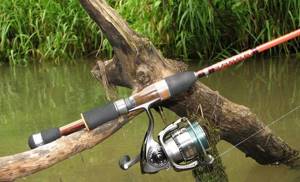
After installing the bracket into the grooves, the clamping is carried out using a worm gear until the fastening element of the butt rests on the leg of the mechanism.
Winding line
Having secured the reel, proceed to winding the selected cord. The tip of the cord is pulled into the winding rings of the rod, starting with the smallest one, located on the quiver tip of the tackle. Having folded the line guide of the spool, the cord is tied to its base. Next, having created tension on the cord, they begin winding, turning the reel at medium speed. The tension allows you to lay the line evenly and without overlaps, which in turn has a positive effect on the unhindered flow of the line and the casting distance of the bait. Thread tension can be created by passing the cord through the pages of a thick book.
Important! After winding the fishing line, there should not be a gap of more than 2 mm to the edge of the spool.
If the thickness of the cord is not enough to ensure this condition, backing is placed on the spool, a material that reduces the presence of free volume.
Connection of fishing line and leash
It is recommended to connect these equipment elements using straight knitting. Since the required leash length is selected immediately before fishing, replacing this accessory during fishing is not required. Carabiners and fasteners will ultimately reduce the delicacy of the equipment, without bringing any practical benefit for the convenience of working with the equipment.
The easiest and most reliable way to connect the leash to the main cord is with uni, clinch or polomar knots. Soft fluorocarbon leaders are connected using the loop-to-loop method.
Mounting the bait
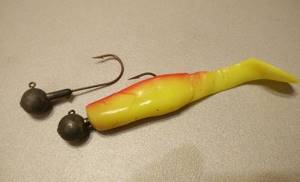
The baits are connected through additional fasteners. This principle allows you not to waste time on the required frequent changes of bait when choosing the most suitable option for fishing conditions. Silicone is placed on hooks with stationary jig heads or hinged weights with fastening loops, through which the baits are connected to the cord fastener. Spoons and wobblers can be attached using winding rings. This operation, although much more complicated than fastening with a fastener, has a lesser effect on the play of baits and the delicacy of the tackle, which is not so important when fastening a jig bait, the animation of which directly depends on the actions of the spinning player himself.
Types of postings for pike
- The simplest type of wiring is when the fishing line is wound evenly onto the reel. This uniformity should be varied by the speed of reeling and the form of the spinning rod, moving it up, down and to the sides. This technique is typical for “oscillators” and “turntables”.
- Carolina tackle with jig baits or “silicone baits” is carried out with stepped wiring. A slight reeling, stopping, moving up with the spinning rod blank and reeling again. First, try to act in the same way throughout the entire wiring. Then, if it doesn’t bite, try to diversify one retrieve with different movements.

